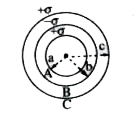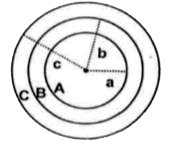Three concentric spherical shells have radii a,b and c(a<b<c) and have surface charge densities σ,−sigam and σ respectively. If VA,VB and VC denote the potentials of the three shells, then for c=a+b, we have
VC=VB=VA
VC=VA≠VB
VC=VB≠VA
VC≠VB≠VA
The correct Answer is:B
To solve the problem, we need to find the potentials VA, VB, and VC for three concentric spherical shells with given surface charge densities and radii. The shells have radii a, b, and c (where a<b<c) and surface charge densities σ, −σ, and σ respectively. We are also given that c=a+b.
Step 1: Calculate the potential VA at radius a
The potential VA due to the three shells can be calculated using the formula for the potential due to a charged shell:
V=14πϵ0⋅QR
Where Q is the total charge on the shell and R is the distance from the center.
1. The charge on the first shell (radius a) is:
QA=σ⋅4πa2
Therefore, the potential VA due to this shell is:
VA=14πϵ0⋅QAa=14πϵ0⋅σ⋅4πa2a=σaϵ0
2. The potential due to the second shell (radius b) is negative because it has a charge density of −σ:
QB=−σ⋅4πb2
Thus, the potential VB is:
VB=14πϵ0⋅−σ⋅4πb2a=−σb2ϵ0a
3. The potential due to the third shell (radius c) is:
QC=σ⋅4πc2
Therefore, the potential VC is:
VC=14πϵ0⋅σ⋅4πc2a=σc2ϵ0a
Combining these, we find VA:
VA=σaϵ0−σb2ϵ0a+σc2ϵ0a
Step 2: Calculate the potential VB at radius b
Using the same approach, we calculate VB:
1. The potential due to the first shell (radius a):
VA=σaϵ0b
2. The potential due to the second shell (radius b):
VB=−σb2ϵ0b=−σbϵ0
3. The potential due to the third shell (radius c):
VC=σc2ϵ0b
Combining these, we find VB:
VB=σaϵ0b−σbϵ0+σc2ϵ0b
Step 3: Calculate the potential VC at radius c
Similarly, for VC:
1. The potential due to the first shell (radius a):
VA=σaϵ0c
2. The potential due to the second shell (radius b):
VB=−σb2ϵ0c
3. The potential due to the third shell (radius c):
VC=σc2ϵ0c=σcϵ0
Combining these, we find VC:
VC=σaϵ0c−σb2ϵ0c+σcϵ0
Step 4: Analyze the results
Now we can analyze the results:
- We have VA, VB, and VC.
- Since c=a+b, we can substitute this into our equations to find relationships between VA, VB, and VC.
Final Result
After simplification, we find that:
VA=VCandVB≠VA,VC
Thus, the final conclusion is:
VA=VCandVB≠VA=VC
QA=σ⋅4πa2
Therefore, the potential VA due to this shell is:
VA=14πϵ0⋅QAa=14πϵ0⋅σ⋅4πa2a=σaϵ0
QB=−σ⋅4πb2
Thus, the potential VB is:
VB=14πϵ0⋅−σ⋅4πb2a=−σb2ϵ0a
QC=σ⋅4πc2
Therefore, the potential VC is:
VC=14πϵ0⋅σ⋅4πc2a=σc2ϵ0a
VA=σaϵ0−σb2ϵ0a+σc2ϵ0a
1. The potential due to the first shell (radius a):
VA=σaϵ0b
VB=−σb2ϵ0b=−σbϵ0
VC=σc2ϵ0b
VB=σaϵ0b−σbϵ0+σc2ϵ0b
1. The potential due to the first shell (radius a):
VA=σaϵ0c
VB=−σb2ϵ0c
VC=σc2ϵ0c=σcϵ0
VC=σaϵ0c−σb2ϵ0c+σcϵ0
- We have VA, VB, and VC.
- Since c=a+b, we can substitute this into our equations to find relationships between VA, VB, and VC.
VA=VCandVB≠VA,VC
VA=VCandVB≠VA=VC
Topper's Solved these Questions
- ELECTROSTATIC POTENTIAL AND CAPACITANCE BOOK - NCERT FINGERTPS ENGLISHCHAPTER - ELECTROSTATIC POTENTIAL AND CAPACITANCE EXERCISE - EXEMPLAR PROBLEMS
3 Videos
- ELECTROSTATIC POTENTIAL AND CAPACITANCE BOOK - NCERT FINGERTPS ENGLISHCHAPTER - ELECTROSTATIC POTENTIAL AND CAPACITANCE EXERCISE - ASSERTION & REASON
15 Videos
- ELECTROSTATIC POTENTIAL AND CAPACITANCE BOOK - NCERT FINGERTPS ENGLISHCHAPTER - ELECTROSTATIC POTENTIAL AND CAPACITANCE EXERCISE - Assertion And Reason
15 Videos
- ELECTROMAGNETIC WAVESBOOK - NCERT FINGERTPS ENGLISHCHAPTER - ELECTROMAGNETIC WAVESEXERCISE - Assertion And Reason
15 Videos
- MAGNETISM AND MATTER BOOK - NCERT FINGERTPS ENGLISHCHAPTER - MAGNETISM AND MATTER EXERCISE - NCERT Exemplar
5 Videos
Similar Questions
Three concentric spherical shells have radii a,b and c(a<b<c) and have surface charge densities σ,−σ and σ respectively. If VA,VB and VC denote the potentials of the three shells, then for c=q+b, we have
View SolutionThree concentric spherical metallic spheres A,B and C of radii a,b and c(a<b<c) have surface charge densities σ,−σ and σ respectively.
View SolutionThree concentric spherical metallic shells A,B,andC of radii a,b,andc(a<b<c) have surface charge densities σ,−σ and σ, respectively.
If VA,VB and VC are potential of shells A, B and C, respectively, match the columns
Column AColumn Ba.VAi.σε0[a2−b2+c2c]b.VBii.σ2ε0[a2b−b+c]c.VCiii.σε0[a−b+c]
View SolutionThree concentric metallic spherical shells A,B and C of radii a,b and c(a<b<c) have surface charge densities +σ,−σand +σ respectively ,the potential of shell B is
View SolutionThree concentric metallic spherical shell A,B and C or radii a,b and c(a<b<c) have surface charge densities −σ,+σand−σ. Respectively. The potential of shel A is :
View SolutionThree concentric spherical metallic shells A,B and C of radii a,b and c (a<b<c) have surface charge densities σ,−σandσ respectively.
If the potential of shell B is VB=σ∈0(anb−b+c) and the potential of shell C is VC=σ∈0(anc−bnc+c) then n is .
View SolutionThree concentric spherical metal shells A.B.C of radii a,b,c(c>b>a) have surface charge density +σ,−σand+σ respectively. The potential of the middle shell is σε0 times

View SolutionThree concentric charged metallic spherical shells A, B and C have radii a,b and c, charge densities σ,−σ and σ and potentials VA,VB and VC respectively. Then which of the following relations is correct?

View SolutionA charge Q is distributed over three concentric spherical shells of radii a, b, c (a< b < c) such that their surface charge densities are equal to one another.
The total potential at a point at distance r from their common centre, where r<a, would be :
View SolutionThere are three concentric thin spheres of radius a,b,c(a>b>c). The total surface charge densities on their surfaces are σ,−σ,σ respectively. The magnitude of the electric field at r (distance from centre) such that a>r>b is:
View Solution
